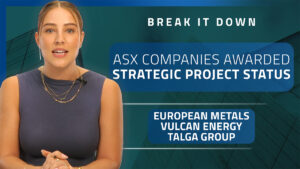The Ethical Investor: Green concrete has been vastly overlooked; and yes, there are ASX stocks in that space

Green concrete has been overlooked in the transition equation. Picture Getty
- Concrete is one area often overlooked in the green transition
- ‘Green concrete’ has the eco credentials to be a key driver in Australia
- The ASX stocks involved in green building technology
Our transition to carbon zero has largely focused on electric vehicles and power grids, but an area often overlooked in Australia’s mission to decarbonise is the construction sector.
When it comes to concrete buildings, experts have hit a major brick wall, with some calling it the “last mile” of decarbonisation.
But concrete is a major contributor of greenhouse gas (GHG), and is the second most consumed product on the planet after clean water.
Concrete is used so copiously that its emissions are greater than all countries except for China and the USA – contributing 8% of the world’s carbon emissions.
Producing concrete is indeed a highly carbon intensive process that involves burning vast amounts of fossil fuel to generate extreme heat.
To put it in perspective, it takes about 54,000 tonnes of cement to construct just one 30-storey tall skyscraper.
Recently, a new report shows how “green concrete” can help pave the way for a sustainable future.
The report from Hatch – a leading global services firm specialising in mining, energy – reveals that replacing just 50% of traditional concrete with green concrete could save approximately 17 million tonnes of Australia’s annual carbon emissions.
Australia has vast potential for green concrete
The author of the report, Hatch engineer Dr Ezgi Kaya, found that green concrete has the eco credentials to be a key driver in reducing Australia’s emissions.

Dr Kaya says green concrete is a sustainable and environmentally friendly alternative to traditional concrete, and an excellent solution for reducing carbon emissions in the construction industry.
“Unlike conventional concrete, which requires a considerable amount of energy and resources to produce, green concrete often uses recycled materials and minimises the use of Portland cement, a major contributor to carbon emissions,” she said.
To date, green concrete has been used in more than 60 projects across different sectors in Australia – including infrastructure, buildings, industrial, marine and geotechnical.
Given that the carbon reduction achieved through its use can be as much as 80%, the potential for green concrete to positively impact our emissions targets is monumental.
Dr Kaya says Australia is a country that has a vast potential for green concrete usage, thanks to our abundance of resources such as recycled aggregates, fly ash and slag.
These materials can be used as a replacement for traditional aggregates and cement, making the production of green concrete more sustainable and eco-friendly.
“Replacing just 50 per cent of traditional concrete with green concrete could reduce Australia’s carbon emissions by approximately 17 million tonnes annually, which is equivalent to removing four million cars from the road,” she explained.
Benefits of green concrete
Green concrete also offers numerous benefits beyond emissions reduction.
It is more durable, more fire resistant, and has higher engineering properties including high early age strength and less shrinkage.
Its use in construction can lead to more sustainable and resilient infrastructure that is better equipped to withstand the impacts of climate change.
Designed to be more sustainable and environmentally friendly than traditional concrete, the key benefits of green concrete include:
Reduced carbon footprint
This is because it typically contains recycled materials such as fly ash, slag, and silica fume, which reduces the amount of cement required to make the concrete.
Cement production is a significant source of greenhouse gas emissions, so reducing the amount of cement needed is one of the most important steps towards reducing the carbon footprint of concrete.
Improved durability
Green concrete often lasts longer than traditional concrete, due to its better resistance to cracking and shrinkage.
This is because it typically contains additives that improve the concrete’s strength and reduce the amount of water needed for mixing, which delivers a more durable finished product.
Energy efficiency
Green concrete may improve energy efficiency.
It is designed to have better insulation properties, thus lowering the amount of energy needed to heat and cool buildings made from the material.
Cost savings
While green concrete is slightly more expensive to produce than traditional concrete, it offers cost savings in the long term.
This is because it typically requires less maintenance and repair over its lifetime, which means lower ongoing costs for building owners and operators.
Reduced waste
Green concrete helps reduce waste by using recycled materials that might otherwise end up in landfills.
This helps conserve natural resources, and reduces the environmental impact of construction projects.
Are we about to see ‘greenflation’?
At the heart of concrete is cement, which is made of clinker – a material mixed out of limestone, clay and sand amongst others.
The cement kilns used in the process have to be heated to a temperature of up to 1,450 degrees Celsius, which obviously releases a vast amount of CO2.
Current technologies to reduce this CO2 include substituting the clinker with more sustainable materials, like residual blast-furnace ash from coal-fired power stations.
Another technology being trialled includes preventing CO2 from being released into the atmosphere altogether. This is done either by injecting it into the ground, or into the resulting concrete itself.
While this is all good, the world is actually facing a paradox because new innovations and technology cost money to develop – lots of it.
This would raise prices in the short term, with the unintended result being ‘greenflation’.
Tighter regulations, reluctance to finance fossil fuel projects, and increased investor focus on ESG could also make things more expensive during this transition phase.
Evergreen Consultants founder, Angela Ashton, said that the cost of decarbonisation is going to be very high.
“This is because certain commodities and skills are going to be sought after in order to create that decarbonisation pathway,” Ashton told Stockhead.
ASX stocks in this space
On the ASX, companies that are developing ‘green’ cement technology include Calix (ASX:CLX).
Calix has a technology it calls Project LEILAC (Low Emissions Intensity Lime and Cement), which reduces carbon dioxide emissions from cement.
Eden Innovations (ASX:EDE) also has a technology that aims to improve the strength and durability of concrete used in infrastructure, while reducing carbon usage.
The company says that all of its patented concrete admixtures enable production of concrete with reduced CO2 emissions.
Meanwhile, construction adjacent companies like First Graphene (ASX:FGR) has cutting-edge graphene that it calls the wonder material of the 21st century.
At just one atom thick, graphene is the thinnest material known to man, but is also said to be 200 times stronger than steel.
Share prices today:
Related Topics
UNLOCK INSIGHTS
Discover the untold stories of emerging ASX stocks.
Daily news and expert analysis, it's free to subscribe.
By proceeding, you confirm you understand that we handle personal information in accordance with our Privacy Policy.








